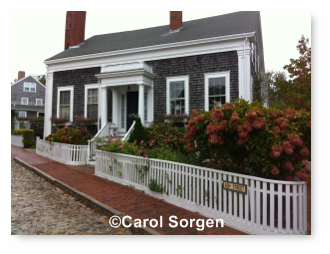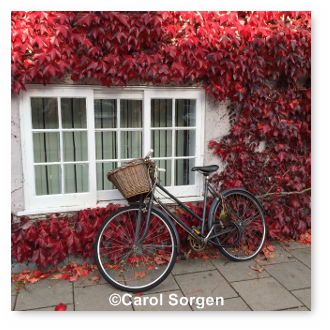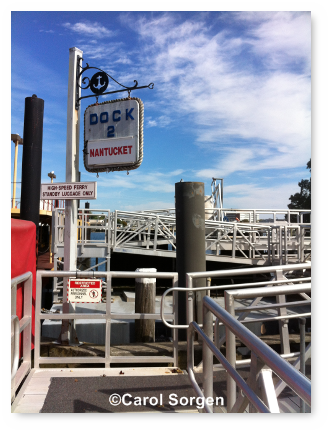Idyllic Nantucket
Baltimore Sun
Where can you go where you'll find nary a traffic light, a fast food restaurant chain, or a neon sign? Where you can walk (carefully please!) centuries-old cobblestone streets, enjoy a clambake on pristine beaches, or set sail from a picturesque harbor lined with grey-shingled shops and restaurants?  It can only be the island, town, and county of Nantucket (the only location in America with the same name for all three municipalities; a name which is derived from an Indian word meaning “faraway land” or “land far out to sea")
It can only be the island, town, and county of Nantucket (the only location in America with the same name for all three municipalities; a name which is derived from an Indian word meaning “faraway land” or “land far out to sea")
Whether you’re a nature lover, sports enthusiast, sailor, history buff, or collector of art and antiques, Nantucket is a vacation destination that appeals to just about everyone.
This pocket-sized island, located 30 miles off the coast of Massachusetts, is just 14 miles long and 3.5 miles wide. (For a bird’s eye view of Nantucket, climb the 93 steps to the steeple of the First Congregational Church at 62 Centre Street.) Approximately 10,000 residents make their home here year-round, but during the summer months that number “blossoms,” as the Chamber of Commerce is fond of saying, to 60,000 (which is just one good reason to go car-less for your visit).
Though visitors may still be discovering Nantucket today, it has a long history nevertheless, dating from 1659 when a group of colonists in search of political and religious freedom joined with Thomas Mayhew of Martha’s Vineyard to purchase Nantucket from the Native Americans for 30 British pounds and two beaver hats. It wasn’t long thereafter that Nantucket became a thriving whaling center.
 In fact, exploring Nantucket’s whaling heritage wouldn’t be a bad place to start your visit. Nantucket was considered the Whaling Capital of the World from 1800 – 1840. During this time, the island was the third-largest city in Massachusetts; only Boston and Salem were larger. Tragically, The Great Fire of 1846 destroyed the wharves and much of the business district. Coupled with the discovery of petroleum, dwindling demand for whale oil, the silting-up of the harbor and discovery of gold in California, the prosperity of the whaling era declined. An economic depression ensured which lasted until the tourism industry replaced whaling as the island’s economic base in the late 19th century, a tradition which continues to this day.
In fact, exploring Nantucket’s whaling heritage wouldn’t be a bad place to start your visit. Nantucket was considered the Whaling Capital of the World from 1800 – 1840. During this time, the island was the third-largest city in Massachusetts; only Boston and Salem were larger. Tragically, The Great Fire of 1846 destroyed the wharves and much of the business district. Coupled with the discovery of petroleum, dwindling demand for whale oil, the silting-up of the harbor and discovery of gold in California, the prosperity of the whaling era declined. An economic depression ensured which lasted until the tourism industry replaced whaling as the island’s economic base in the late 19th century, a tradition which continues to this day.
For a glimpse of what first made Nantucket so prosperous, visit the Nantucket Whaling Museum (13 Broad Street). Restored in 2005, this popular, interactive Museum features an 1847 spermaceti candle factory, sperm-whale skeleton, fully rigged whaleboat, collection of whaling tools and portraits of whaling captains, a children's discovery room, and an observation deck that overlooks Nantucket Harbor.
Nantucket's whaling industry may be extinct, but you can still see live whales in action by signing up for a whale or seal-watching cruise (check out Shearwater Excursions and Nantucket Adventures).
O n land, much of Nantucket’s charm lies down its narrow lanes that give you the sense of stepping back a century…or two or three. The island is home to more than 800 iconic grey-shingled houses built between 1740 and 1840, almost all of which are located in their original setting. Nantucket, in fact, claims one of the largest and best-preserved historic districts in the United States. Because of the grey-shingled buildings and frequent fog, Nantucket is affectionately referred to as the “Little Grey Lady of the Sea.”
n land, much of Nantucket’s charm lies down its narrow lanes that give you the sense of stepping back a century…or two or three. The island is home to more than 800 iconic grey-shingled houses built between 1740 and 1840, almost all of which are located in their original setting. Nantucket, in fact, claims one of the largest and best-preserved historic districts in the United States. Because of the grey-shingled buildings and frequent fog, Nantucket is affectionately referred to as the “Little Grey Lady of the Sea.”
The Nantucket Historical Association cares for a number of these properties, almost all of which are within a half-mile of Main Street. Several are now museums and well worth a visit, including The Jethro Coffin House, also known as the Oldest House (Sunset Hill Road), built around 1686; and the 1745 Macy-Christian House (12 Liberty Street) and 1845 Hadwen House (96 Main Street), the latter a Greek Revival captain's mansion that signified the prosperous times brought to Nantucket through the whaling industry.
During the 18th century, a large missionary-led Quaker movement was established on the island, and its influence can still be seen in some of the plainer Quaker-style homes that also line Nantucket’s Main Street and many of its small lanes; among them the Maria Mitchell Birthplace House (2 Vestal Street), built in 1790 and home of America’s first woman astronomer (join members of the Maria Mitchell Association on nature and wildflower walks and birding field trips, or help them collect island marine life for the Maria Mitchell Aquarium).
If you run out of reading material, stop by the Nantucket Atheneum (1 India Street). Located in an elegant and historic Greek Revival building that dates to 1847, this free public library is one of the oldest in continuous use in the United States. The library’s holdings include approximately 42,000 volumes, historic paintings, sculpture, ship models, and scrimshaw. The adjoining Atheneum Park makes a nice spot for reading and relaxing. (Bibliophiles will also be pleased to find that the Island is home to two independent bookstores downtown, Mitchell's Book Corner and Nantucket Bookworks, where you'll find not only books but Island-inspired cards, bookmarks, gifts, and the like.)
 Nantucket is a nature lover’s paradise; nearly 46 percent of the island is protected conservation land. There are bike paths that lead to Madaket, Dionis, Surfside, and Siasconset (familiarly known as ‘Sconset) beaches, and also more than 8,400 acres of undeveloped land that can be explored by visitors to the island. The less adventurous can follow the Sanford Farm-Ram Pasture Walking Trail, a marked hiking trail that offers 15 miles of wilderness owned and managed by the Nantucket Conservation Foundation.
Nantucket is a nature lover’s paradise; nearly 46 percent of the island is protected conservation land. There are bike paths that lead to Madaket, Dionis, Surfside, and Siasconset (familiarly known as ‘Sconset) beaches, and also more than 8,400 acres of undeveloped land that can be explored by visitors to the island. The less adventurous can follow the Sanford Farm-Ram Pasture Walking Trail, a marked hiking trail that offers 15 miles of wilderness owned and managed by the Nantucket Conservation Foundation.
A number of artists and craftspeople make Nantucket their home and if you’d like to pick up a brush yourself, there’s no shortage of opportunities to take art classes. The Artists’ Association of Nantucket, the Nantucket Island School of Design and the Arts, and Shredder’s Studio, are some of the locales that offer classes in drawing, painting, ceramics, mixed media, basketry, jewelry making, art, and nature.
If you’d rather buy the works of other talented artists, there are more than 100 shops on the island that carry antiques and fine arts, as well as the traditional handcrafts of scrimshaw and Nantucket lightship baskets.
One of the more popular items among nautical antiques, scrimshaw is the folk art of the whalers. Although a 1971 embargo on the importation of new whaling products is still in effect, old bone and ivory from whaling stations going back 50 to 100 years can still be sold.
Another ideal souvenir from a trip to the island would be a Nantucket lightship basket. Named for the South Shoal Lightship, a floating lighthouse anchored off Nantucket Island from 1854 to 1905, original Nantucket lightship baskets were made from tightly woven rattan with sturdy wooden bottoms and swinging handles. They were round or oval in shape, open on top, and were frequently made in nesting sets of five to eight baskets. Designed to tote anything from potatoes to firewood, the baskets were made to while away the long, lonely hours on board ship and were frequently given to wives left on shore.
When the lightship era ended in 1905, so did the era of the lightship basket, until it wasresurrected again in the 1940s. Jose Reyes, a Harvard-educated Filipino then living on Nantucket, wanted to make a basket for his mother. To his basket, he added a lid so it could be used as a purse, and thus brought about the contemporary Nantucket lightship basket. Don’t miss a visit to the Nantucket Lightship Basket Museum (49 Union Street) with permanent and temporary exhibits, and educational programs such as demonstrations and workshops.
Like many other seaside towns, Nantucket has become a year-round destination with a number of festivals and events to draw visitors back often. The annual Daffodil Festival Weekend in April, Historic Preservation Week and the Nantucket Wine Festival, both in May, the Nantucket Film Festival in June, and the annual Nantucket Race Week in August (eight days of regattas, awards ceremonies, and parties hosted by Nantucket Yacht Club and Great Harbor Yacht Club to benefit Nantucket Community Sailing) keep the spring and summer season going. But thinkabout coming after high season as well, for the Nantucket Arts Festival, “Fall on Nantucket,” throughout October and November; and the annual Christmas Stroll Weekend, when you can enjoy an old-fashioned holiday celebration featuring over 150 Christmas trees throughout town, Victorian carolers, bell-ringers, a house tour, and more. Christmas Stroll is part of the month-long Nantucket Noel celebration that starts on Thanksgiving and continues through New Year’s.(A planning note—if you do choose to visit after high season, which usually ends with Columbus Day weekend, be advised that many attractions and even some restaurants, shift to a winter schedule, with limited hours/days, and in some cases, may be closed until the season begins again the following spring).
If You Go…
Nantucket Island is located 30 miles off the coast of Massachusetts. From Hyannis (80 miles from Boston), the Steamship Authority (508-495-3278) and Hy-Line (800-492-8082) provide regular and high-speed ferry service to Nantucket year-round. The Steamship Authority carries passengers, bicycles and cars (reservations required; cars, however, are strongly discouraged on the island), while the Hy-Line accommodates only passengers and bicycles. Several airlines have scheduled flights to Nantucket from Boston, New York, New Jersey, Providence, Hyannis, Martha’s Vineyard, and/or New Bedford.
Nantucket offers a wide variety of accommodations, from large full-service properties to smaller bed and breakfasts or cottage rentals. Several favorite choices: The Periwinkle Inn Bed and Breakfast, 9 North Water Street, Nantucket, (508) 228-9267, www.theperiwinkle.com, a cozy 19th century home just two doors from the Whaling Museum with up-to-date amenities but old-fashioned charm; Jared Coffin House, 29 Broad Street, 508-228-2400, www.jchouse.com, agrand brick home built in 1845 and restored to its original beauty by the Nantucket Historical Trust; The Wauwinet, 120 Wauwinet Road, 800-426-8718, www.wauwinet.com, located on the beach, and the island’s most deluxe property; the Cliffside Beach Club, 46 Jefferson Street, 508-228-0618, www.cliffsidebeach.com, also situated beachfront and about a mile’s walk from town, combining old-word character with contemporary amenities; and the recently opened Nantucket Hotel & Resort, 77 Easton Street, 1-866-807-6011 (toll-free), www.thenantuckethotel.com, first opened in 1891 and now completely refurbished in a casual but upscale nautical and family-friendly style.
As with accommodations, dining options also abound on the Island. For a quick lunch, try Fog Island Grille or, if you're in the mood for a picnic, Nantucket Gourmet. The lobster roll at Queequeg's Restaurant is a great way to start your culinary vacation. Follow that with dinner at the intimate, unpretentious Centre Street Bistro. For harbor view dining, Cru Oyster Bar will satisfy all your seafood cravings.
For an overview of the island from a 6th-generation Islander, see Nantucket with Gail's Tours; you’ll enjoy Gail’s first-person reminiscences as well as plenty of time for photo opps (and Nantucket is one picture-postcard opportunity after another). For reservations, call 1-508-257-6557.
To help you plan your trip, call the Nantucket Island Chamber of Commerce at 508-228-1700and request the “Official Guide,” or visit online at www.nantucketchamber.org.